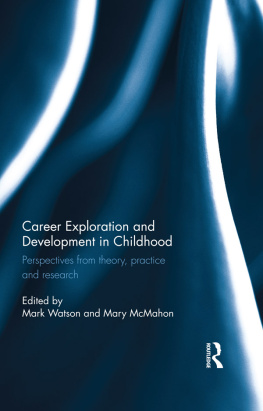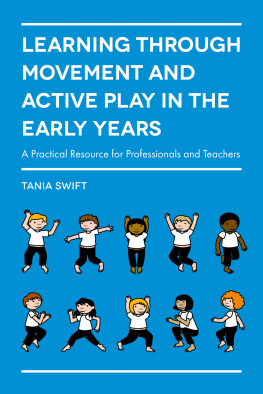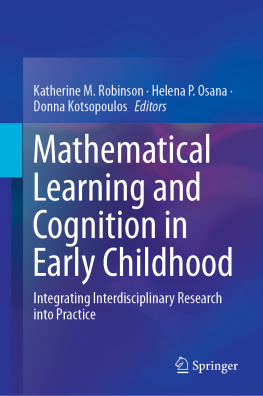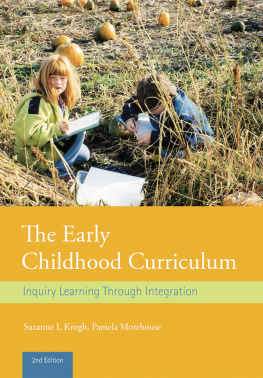
Published by Redleaf Press
10 Yorkton Court
St. Paul, MN 55117
www.redleafpress.org
2009 by Dave Riley, Mary Carns, Ann Ramminger, Joan Klinkner, and Colette Sisco
All rights reserved. Unless otherwise noted on a specific page, no portion of this publication may be reproduced or transmitted in any form or by any means, electronic or mechanical, including photocopying, recording, or capturing on any information storage and retrieval system, without permission in writing from the publisher, except by a reviewer, who may quote brief passages in a critical article or review to be printed in a magazine or newspaper, or electronically transmitted on radio, television, or the Internet.
First edition 2009
Cover design by Fiona Raven
Cover photographs by Steve Wewerka
Interior typeset in Sabon and composition by Navta Associates Inc.
Library of Congress Cataloging-in-Publication Data
Intellectual development : connecting science and practice in early childhood settings / Dave Riley ... [et al.].
p. cm.
Includes bibliographical references and index.
ISBN 978-1-605543-40-6 (e-book)
1. Early Child educationActivity programs. 2. Cognition in children. 3. Child development. I. Riley, Dave.
LB1139.35.A37I58 2009
372.21dc22
2008006817
This book could not have been written without the support of our families, the wisdom of our teachers, and the many children who have taught us... to look, to see, to understand, to appreciate, to love, and most of all, to play. We dedicate this book to all of you, and in particular:
To my ECE teachers, Emily Diaz, Mary Montalvan, Georgie Feeney, and Betty Jones. (DR)
To my first playmate, my sister Becky, and to Ben, Amy, and Noah, who make life fun. (MC)
To Bob, Kyle, Aaron, Nathan, and Beema for support and inspiration. (AR)
To my husband, Mike, and our daughters Lisa and Valerie, for their love and support. (JK)
To my sons Matthew, Ben, and Michael who are my consummate teachers about life. (CS)
To my husband, Jerry, and our daughters Sadie, Sara, Liz, and Erin. (KB)
To my children Emma, Ansel, and Charlotte, who continue to help me grow and learn. (CCE)
To my husband, Jim, and my amazing children, Elizabeth and Thomas. (MR)
To my siblings Maribel, Maricel, and Ron, and also the Harman family: Emma, Chris, and Vanessa. (RSJ)
There is a little piece of each of you within these pages.
Intellectual Development
A parent had heard this was a good early childhood center, but she was not impressed when she came to observe and saw the morning activity: the children clapped their hands while singing a silly song, I like to eat, eat, eat, eeples and beneenies, I like to oat, oat, oat, oples and bononos... The parent asked the teacher, Dont you do anything educational?
The teacher didnt know how to respond. She had been taught to do this kind of activity by a highly respected Master Teacher, who had explained that it was important to child development. But the teacher didnt know exactly what part of child development it addressed. She was doing early childhood education as she had been taught, and as the children loved it, but she had no understanding of the reasons for developmentally appropriate practice.
Because this teacher didnt understand the reasons for good practice in early education, she was unable to explain the benefits of different classroom activities to either the parent or to her new teachers assistant. Because she could not interpret her classroom to the parent, the parent was then unlikely to view this classroom as an educational setting (which is a key reason why many parents see no justification for higher fees to pay higher staff wages). If this teacher understood the whys behind her practices, she would feel more like a professional teacher, and she would be able to sell her program in a way that could lead to more professional wages.
This book was written, in part, to help this teacher answer the parents question, and the thousand other similar questions we get about our classroom practices. This book explains why we do what we do in early care and education. The book you are currently reading covers intellectual development. We have also written a companion volume: Social and Emotional Development: Connecting Science and Practice in Early Childhood Settings.
In fact, knowing the whys underlying our practices also can improve those practices. Many of our most skilled early childhood teachers have honed their skills into an automatic, unconscious pattern of wonderful classroom practices. These teachers are so skilled that they dont have to think about what they are doing. However, if this book makes them more conscious of their skills and how these skills influence child development, then they can exercise those skills more consistently and mentor them to new teachers more easily. Maria Montessori was the first (and Jean Piaget the best) to point this out, that we often learn things unconsciously through our everyday actions. However, if we raise an unconscious skill to the conscious, conceptual level, then we have a new kind of control over the skill and can wield it in a more powerful way.
Knowing the whys underlying good practices can be very rewarding to any teacher, and particularly the best teachers. Many of the everyday practices of early care and education can seem hum-drum and unimportant (for example, singing with children, doing art projects, or talking with them about what they are doing). However, the best scientific research of the last two decades has shown conclusively that some of these everyday activities make a huge difference in childrens development. These early differences can lead to differences in outcomes across the whole lifespan. Reading this book should give most early childhood teachers a dramatically raised appreciation of the significance of their work. Very few occupations make as large a difference in so many lives.
The ability to explain the whys of good practice is also important for another reason. Policy makers are increasingly interested in extending public education into lower ages, beginning with a movement toward publicly funded prekindergarten in many U.S. states. This trend could be very good not only for children, but also for elementary education, because a linkage and partnership could form between early childhood and elementary education programs. Although most of us see the potential benefit of this relationship, we also fear the possibility that the methods of most elementary education programs may simply be extended downward into classrooms for four-year-olds and three-year-olds. Based on what we know of child development, this would benefit neither the children nor society. In our view, elementary education may have more to learn from early care and education programs, about working with young children, than the other way around.
Elementary teachers are often trained in schools of education, which focus more on the curriculum and practice of teaching than on how children learn. If the teacher has a focus on curriculum (the subject matter to be mastered), then providing the same experiences and instruction to the whole class at once seems natural and indeed efficient. If the focus is on curriculum, an individual childs emotions become a distraction from learning, rather than the key to active and motivated learning.
In contrast, the roots of early childhood education lie in a different field of study: not education, but child development. This field begins by asking how children grow and learn. When you are part of this tradition, as most early childhood teachers are, then teaching doesnt start with the curriculum to be mastered, noticing childrens deficiencies. Instead, you begin with what the child currently understands, and you build from there. With this perspective, treating every child differently seems natural, as each child approaches the topic with different understandings, learning through her own experiences. Thus, the growth of knowledge is understood in the same way cognitive scientists understand it: as something the child actively constructs through self-motivated actions and experience, not as something we pour into the child from the outside.
Next page






